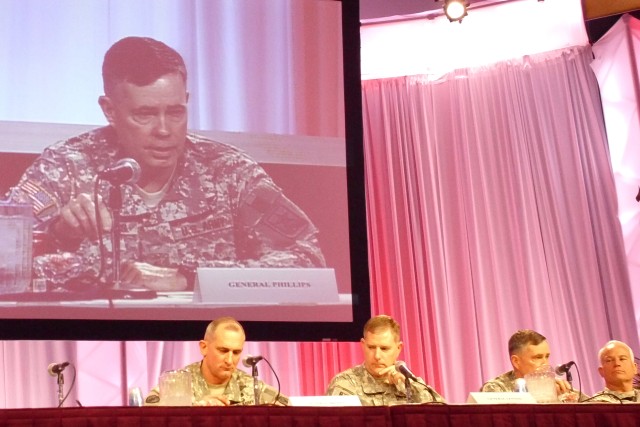
FORT LAUDERDALE, Fla. (Feb. 28, 2010) -- U.S. Army leaders and their industry counterparts agreed that they can work together to increase productivity and help identify areas of economic efficiency and cost savings in an era of constrained resources, speaking Feb. 25, during a joint panel discussion here at the Association of the United States Army Winter Symposium, here.
"We need a strong relationship with our industry partners so they can give us the feedback needed to make the best decisions possible," said Lt. Gen. Bill Phillips, principal military deputy to the assistant Secretary of the Army for Acquisition, Logistics and Technology.
The "efficiencies" discussion was grounded in guidance from Defense Secretary Robert Gates and a Sept. 14, 2010 memo from Ashton B. Carter, under secretary of Defense for Acquisition, Technology and Logistics titled "Better Buying Power: Guidance for Obtaining Greater Efficiency and Productivity in Defense Spending Initiatives."
Gates' guidance and the Carter memo call upon the services to find areas of economic efficiency by eliminating redundancy, moving to more fixed-price contracts, increasing competition among industry partners and achieving cost savings where possible, among other things.
Essentially, the guidance on efficiency asks the services to "do more without more," implicitly recognizing that the overall defense budget is not expected to increase in coming years as it has in recent years.
With these tenets in mind, Phillips emphasized the need for the Army to identify executable and affordable requirements and sound acquisition strategies. Along these lines, he cited the Ground Combat Vehicle Request for Proposal as an example of the Army properly aligning and prioritizing requirements, resources and acquisition strategy.
The Ground Combat Vehicle Request for Proposal called for a "tiering" of requirements and clear-cut cost goals so that industry would understand what was being asked and have the trade-space necessary to fashion technologically mature solutions able to meet the requirements outlined in the proposal.
Getting this right calls for proper collaboration across a range of stakeholders, Phillips explained.
"We must be output-focused and resourced informed. When we talked about Ground Combat Vehicle, this is what we are getting at. Today for a major program - the acquisition, sustainment, and resourcing teammates must all be actively involved and engaged in the process before we begin to think about requirements generation," Phillips said.
Another possible area of efficiency centers around looking throughout industry and across the services to collaborate on weapons production, Phillips said.
"As we work through the efficiencies with OSD [Office of the Secretary of Defense], it's important that we work with our industry partners," Phillips said. "If you look at missiles built by the Army, Navy and Air Force - are there opportunities for the industrial base or a company to leverage what all the services require in order to gain efficiencies by using the same production line'"
A key element of the drive for efficiencies is the recognition that much of the cost savings will be re-invested in Army programs, he said.
"The efficiencies that we have gained within our programs, stay within our programs. We expect our PEOs (Program Executive Offices) to retain the savings within the portfolio so they can do better things for Soldiers within their programs," Phillips said.
Testing is another area where potential efficiencies can be gained, he said.
"Test is a critical part of every program. We should test to standard. We shouldn't over test, but we shouldn't under-test either. There is a balance when it comes to making sure that you have a viable program that is going through the right testing procedures to validate that the systems we're fielding are safe and suitable," Phillips said.
Lt. Gen. Bob Durbin, acting director of the Office of Business Transformation, discussed the importance of looking at enterprise business processes across the Army, emphasizing posturing to effectively and efficiently execute programs across the business enterprise. "Clearly there are efficiencies to be gained across our enterprise business processes," Durbin said.
The drive to achieve efficiencies is not intended to result in decreased industry profits, but rather developed to function as a method of incentivizing and inspiring greater industry productivity, panelists said.
"I don't see efficiency initiatives and profits being mutually exclusive,"
said Steve Zink, vice president, Oshkosh Defense strategy and planning.
"It's achievable to think we can achieve a win-win," said Mick Maurer, president of Sikorsky military systems.
Related Links:
STAND-TO!: Army Business Transformation
Office of the Assistant Secretary of the Army for Acquisition, Logistics and Technology - OASA(ALT)

Social Sharing